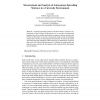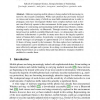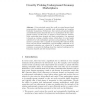DIMVA
2007
14 years 1 months ago
2007
Abstract. We present two light-weight worm detection algorithms that offer significant advantages over fixed-threshold methods. The first algorithm, RBS (ratebased sequential hy...
DIMVA
2007
14 years 1 months ago
2007
Abstract. Autonomous spreading malware in the form of bots or worms is a constant threat in today’s Internet. In the form of botnets, networks of compromised machines that can be...
DIMVA
2010
14 years 1 months ago
2010
Black-box web vulnerability scanners are a class of tools that can be used to identify security issues in web applications. These tools are often marketed as "point-and-click ...
DIMVA
2010
14 years 1 months ago
2010
Abstract. Malware targeting mobile phones is being studied with increasing interest by the research community. While such attention has previously focused on viruses and worms, man...
DIMVA
2010
14 years 1 months ago
2010
Abstract. Skype is one of the most used P2P applications on the Internet: VoIP calls, instant messaging, SMS and other features are provided at a low cost to millions of users. Alt...
DIMVA
2010
14 years 1 months ago
2010
Abstract. In order to obtain and maintain control, kernel malware usually makes persistent control flow modifications (i.e., installing hooks). To avoid detection, malware develope...
DIMVA
2010
14 years 1 months ago
2010
Computer security competitions and challenges are a way to foster innovation and educate students in a highly-motivating setting. In recent years, a number of different security co...
DIMVA
2010
14 years 1 months ago
2010
We present Conqueror, a software-based attestation scheme for tamper-proof code execution on untrusted legacy systems. Beside providing load-time attestation of a piece of code, Co...
DIMVA
2010
14 years 1 months ago
2010
Cyber-criminals around the world are using Internet-based communication channels to establish trade relationships and complete fraudulent transactions. Furthermore, they control an...
DIMVA
2010
14 years 1 months ago
2010



